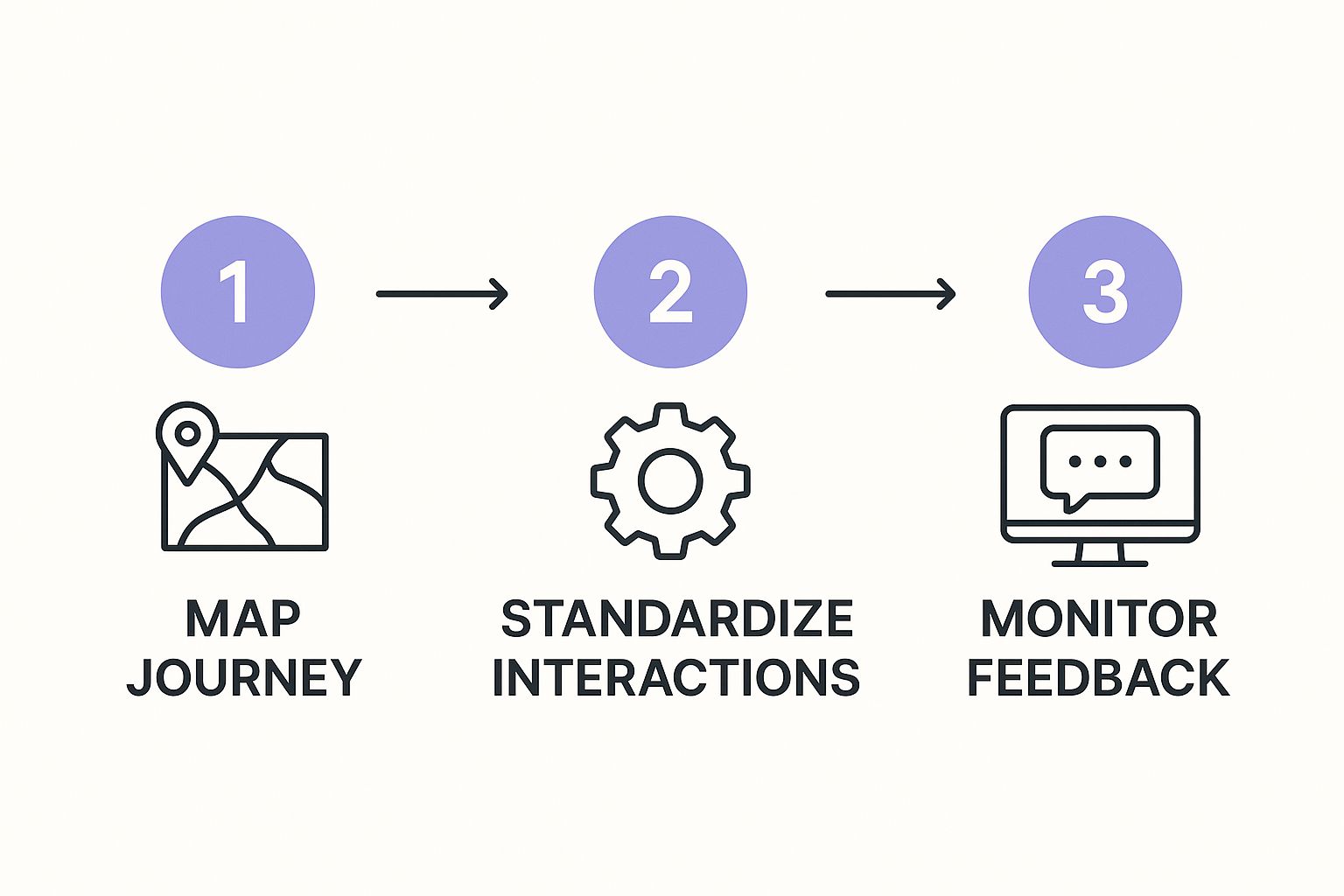Why Channel Consistency Makes or Breaks Customer Loyalty

Today's customer journey is fragmented. Customers interact with brands across numerous touchpoints, from websites and apps to social media and physical stores. This creates a complex web of interactions, making consistency absolutely essential. Brands must provide a seamless experience regardless of how a customer chooses to engage.
The Importance of Seamless Transitions
Customers expect smooth transitions between channels. Imagine starting a purchase on your phone and seamlessly finishing it on your computer. This frictionless experience builds trust and creates a positive brand image.
Conversely, inconsistencies, like conflicting information or different brand voices across channels, can damage that trust. For example, a promotional email with a broken discount code at checkout creates a negative experience.
This seemingly small issue can significantly impact customer confidence. Such negative experiences can quickly lead to abandoned purchases or customers switching brands.
Multichannel Vs. Omnichannel: A Critical Distinction
Many businesses operate across multiple channels, but this doesn't guarantee a consistent customer experience (customer satisfaction score calculation). Simply being present on various platforms is multichannel. True omnichannel integrates these channels for a unified, cohesive experience.
This integrated approach is now the standard customer expectation. Providing a consistent customer experience across channels is crucial. In fact, 62% of customers want to engage with brands across multiple channels, emphasizing the importance of an omnichannel communication strategy. However, 77% of brands struggle to create a cohesive customer journey, highlighting a gap between expectations and capabilities. Find more detailed statistics here: Learn more about customer experience statistics
Building Loyalty Through Consistent Experiences
Ultimately, consistent cross-channel experiences are more than just convenient. They build trust and foster customer loyalty. When a brand consistently meets or exceeds expectations across all touchpoints, it strengthens customer relationships and encourages repeat business.
This leads to higher customer lifetime value and sustainable growth. Prioritizing channel consistency will be a key differentiator for businesses in today's market.
The Hidden Revenue Impact of Cross-Channel Consistency

Beyond simply pleasing customers, a consistent experience across all channels significantly impacts a business's bottom line. While often overlooked, the financial implications are substantial. Providing a consistent experience directly influences crucial metrics like purchasing behavior, average order value, and customer lifetime value.
The Financial Benefits of Consistency
Companies that prioritize a consistent customer experience across channels often see numerous positive financial outcomes. For instance, improvements in customer lifetime value are a common result. This occurs because consistent experiences build loyalty, encouraging repeat business and higher spending over time.
In addition, acquisition costs often decrease. Satisfied customers become natural brand advocates, organically attracting new customers through word-of-mouth and positive online reviews. Explore proven strategies for creating lasting customer loyalty, a key component of a consistent cross-channel experience: How to Create Customer Loyalty
This ultimately leads to accelerated revenue growth. By focusing on a seamless and unified experience, businesses unlock significant financial gains. This, in turn, creates a cycle of success where happy customers drive further growth.
The Hidden Costs of Inconsistency
Conversely, inconsistent experiences can create hidden costs that negatively affect revenue. These costs often go undetected by traditional metrics. For example, abandoned carts, a frequent sign of inconsistent online experiences, directly impact sales. This can happen if the checkout process differs significantly from browsing or if unexpected shipping costs appear.
Furthermore, inconsistent brand messaging or service levels can lead to silent customer defections. Customers may simply disengage without giving feedback, making it challenging to identify and resolve the root issues. In fact, the demand for consistent experiences is directly tied to customer retention and loyalty. Over 50% of customers will switch to a competitor after just one bad experience, with 57% abandoning a brand after a single negative interaction. Learn more about customer retention and discover additional statistics: Find more detailed statistics here
Calculating the ROI of Consistency
While these individual costs may appear small, they accumulate significantly. Businesses need to develop methods for calculating their "consistency ROI". This involves quantifying the financial effects of both consistent and inconsistent experiences.
By understanding the real cost of inconsistency, companies can justify investments in improving the cross-channel experience. This data-driven approach helps gain executive support and allocate resources effectively.
Mapping The Moments That Matter Across Customer Touchpoints
Creating a consistent customer experience across multiple channels requires a deep understanding of the customer journey. If you're a customer service manager looking for expert advice, check out our customer service manager tips. It's about more than just having a presence on various platforms; it's about meticulously mapping every interaction to reveal critical consistency gaps. This approach goes beyond basic journey mapping to create a dynamic, actionable plan.
Identifying Key Touchpoints
The first step is identifying the key touchpoints – those interactions that significantly influence customer perception. These moments can be either digital or physical. For instance, a customer might discover your brand through a social media ad, browse your website, contact customer service, and finally purchase in-store. Each touchpoint contributes to the overall experience.
Understanding these key touchpoints and their associated pain points requires gathering meaningful customer insights. Effective techniques include:
-
Ethnographic Research: Observing customers in their natural settings to understand their behavior and needs.
-
Contextual Interviews: Engaging in detailed conversations with customers to explore their experiences and motivations.
-
Advanced Analytics: Analyzing data from website interactions, CRM systems, and other sources to identify patterns and trends.
Prioritizing Improvements For Maximum Impact
After identifying key touchpoints, successful brands prioritize improvements based on customer impact and business value. Addressing pain points in high-impact moments can dramatically improve customer satisfaction and loyalty. However, these improvements should align with overall business objectives.
The infographic below visually represents this process:

This infographic illustrates the three crucial steps for consistent customer experience: mapping the journey, standardizing interactions, and continuously monitoring feedback for improvement. Following these steps helps businesses meet customer expectations and drive continuous improvement.
To help visualize how different channels play a role at various stages of the customer journey, consider the following table.
This table, the Channel Touchpoint Matrix, will help organizations map customer touchpoints across different channels to identify consistency gaps and opportunities.
| Customer Journey Stage | Website | Mobile App | Physical Store | Customer Service | Social Media |
|---|---|---|---|---|---|
| Awareness | Discovering product information through blog posts and articles | Seeing targeted ads | Window shopping and noticing promotional displays | N/A | Engaging with organic content and social media ads |
| Consideration | Comparing product features and reading reviews | Browsing products and adding to wishlist | Interacting with sales staff and trying out products | Answering pre-sales questions via phone or email | Participating in online discussions and seeking recommendations |
| Purchase | Completing online checkout | Making a purchase through the app | Buying the product in-store | Processing returns or exchanges | Clicking on shoppable posts |
| Post-Purchase | Accessing support documentation and FAQs | Receiving push notifications about order updates | Receiving personalized recommendations in-store | Handling customer service inquiries | Engaging with brand communities and providing feedback |
| Advocacy | Joining loyalty programs | Leaving app reviews | Participating in in-store events | Receiving proactive customer service | Sharing positive experiences and recommending the brand |
The Channel Touchpoint Matrix highlights how each channel contributes to the customer journey, emphasizing the need for a consistent experience across all interactions.
Building Governance For Consistency And Innovation
Maintaining a consistent customer experience requires a governance framework. This framework defines roles, responsibilities, and processes to ensure all touchpoints adhere to brand standards. A style guide, for example, ensures consistent brand voice and messaging.
However, this framework shouldn't stifle innovation. It needs to balance standardization with flexibility, allowing individual channels to experiment and optimize. Striking this balance is crucial for delivering seamless, integrated experiences that meet evolving customer needs.
Tech Stack Secrets for Seamless Cross-Channel Experiences

Building a consistent customer experience across different channels is a significant undertaking. The technology you choose plays a crucial role in your success. The right tools can empower your business to create unified, personalized experiences, while the wrong ones can lead to frustrating inconsistencies for your customers. This section explores the essential technologies and strategies for a truly seamless cross-channel experience.
The Evolving Technology Ecosystem
The technology available for managing customer experience is in constant flux. Customer Data Platforms (CDPs), for example, are quickly becoming indispensable for building a unified view of each customer. These platforms consolidate data from various sources, giving businesses a single source of truth. This comprehensive view enables personalized messaging and consistent offers across all channels.
Intelligent orchestration systems also play a key role in coordinating messaging across various customer touchpoints. These systems automate communications based on individual customer behaviors and preferences, ensuring each interaction is timely and relevant. For instance, if a customer abandons their online shopping cart, the system can automatically trigger a personalized email reminder. Integrating your tech stack, including platforms like Shopify Social Media Integration, is crucial for this seamless cross-channel experience.
Choosing the Right Solutions
When evaluating technology solutions, it's important to focus on your specific business requirements. Don't be swayed by an extensive list of features that may not be relevant to your current needs. Consider your organizational maturity and select solutions aligned with your overall business goals and available resources. A small business, for instance, likely won't have the same complex needs as a large enterprise, and therefore doesn't require the same level of technological investment.
The following table, "Technology Solutions Comparison", provides a breakdown of key technologies commonly used to create consistent cross-channel experiences. It highlights the features, benefits, and challenges of each solution, helping you choose the best fit for your business.
| Technology Type | Key Features | Benefits | Implementation Challenges | Best For |
|---|---|---|---|---|
| Customer Data Platform (CDP) | Unified customer profiles, data segmentation | Personalized messaging, targeted campaigns, improved insights | Data integration, cost | Businesses with multiple data sources |
| CRM System | Customer interaction tracking, sales automation | Improved customer relationship management, increased efficiency | Data migration, user adoption | Sales and marketing teams |
| Marketing Automation Platform | Automated campaigns, email marketing | Streamlined marketing processes, lead nurturing | Integration with other systems, complexity | Businesses focused on lead generation |
| Analytics Dashboard | Real-time data visualization, reporting | Performance monitoring, data-driven decision making | Data accuracy, interpretation | All businesses |
As this table demonstrates, each technology offers unique strengths. Carefully consider your specific requirements when making a decision.
Breaking Down Data Silos and Leveraging AI
Many organizations struggle with data silos, where valuable customer information is scattered across various departments and systems. Breaking down these silos is essential for a unified customer view. However, this doesn't necessarily require a massive IT overhaul. A good first step is identifying your key data sources and creating a strategy for gradually integrating them.
Forward-thinking brands are now using AI and predictive analytics to further personalize experiences while maintaining brand consistency. AI can analyze customer data to predict future behavior and personalize interactions, leading to more relevant offers and greater customer satisfaction. This enables businesses to deliver the right message, at the right time, on the right channel. This focus on data-driven personalization is crucial for building a truly seamless and consistent customer experience across all channels.
Building Teams That Transcend Channel Silos
Delivering a consistent customer experience across multiple channels requires more than just technology and a well-defined strategy. It requires a fundamental shift in how teams are structured and collaborate. Traditionally, businesses operate within channel silos. This means individual teams focus solely on their designated channel, like a website, social media platform, or physical store.
This siloed approach often leads to fragmented customer experiences and internal conflicts. This section explores strategies for dismantling these silos and building integrated teams that prioritize the entire customer journey.
Transforming Siloed Teams
Experience-led companies understand the value of cross-functional collaboration. Instead of isolated teams working independently, they create integrated units with shared customer-focused objectives. This approach fosters a sense of collective responsibility for the customer's overall experience.
For instance, a cross-functional team might include members from marketing, sales, customer service, and product development. They would all work together to enhance a specific aspect of the customer journey. This shared focus helps eliminate inconsistencies between channels and creates a more unified brand experience.
Emerging Organizational Models
Various organizational models can support a customer-centric approach. Some companies establish dedicated customer journey teams. These teams own specific stages of the customer lifecycle, such as onboarding or customer retention. Others employ experience architects who oversee the design and implementation of consistent experiences across all customer touchpoints.
These emerging models aim to balance the need for specialized channel expertise with the critical need for a unified customer experience.
Practical Approaches to Collaboration
Several key practices contribute to effective cross-channel teamwork:
-
Establishing Effective Governance: Clear roles, responsibilities, and decision-making processes are essential for aligning teams around customer-focused goals. This could involve creating a central customer experience (CX) team or assigning ownership of specific customer journeys to individuals.
-
Creating Meaningful Cross-Team Metrics: Measuring success based on shared metrics, such as overall customer satisfaction or customer lifetime value, encourages teamwork. This shifts the focus from individual channel performance to the overall success of the customer experience.
-
Developing Collaboration Protocols: Regular cross-team meetings, shared communication platforms like Slack, and documented workflows facilitate seamless information sharing and collaboration. These protocols establish a framework for consistent communication and knowledge transfer, minimizing the risk of disjointed experiences.
These practices help break down communication barriers and foster shared ownership of the customer experience. This, in turn, leads to quicker problem-solving and more efficient implementation of strategies across all channels.
Navigating the Transition
Moving from a channel-centric to a customer-centric model requires careful change management. Clearly communicating the benefits of this transition to everyone involved is crucial. Providing adequate training and support, along with celebrating early successes, can help build momentum and ensure buy-in across the organization.
By embracing these changes, businesses can create a strong foundation for providing a consistent customer experience. This ultimately improves customer satisfaction, increases loyalty, and drives business growth. Using tools like FlowGent AI can further enhance this process by providing consistent AI-powered support across customer-facing channels. Learn more about how FlowGent AI can help deliver seamless, human-quality support 24/7.
Measuring What Matters: Beyond Channel-Specific Metrics
Traditional, channel-focused metrics often miss the bigger picture of a truly consistent customer experience. While data like website traffic, social media engagement, and in-store sales offer valuable insights, they only provide a fragmented view of the customer journey. We need to move beyond these isolated data points and embrace a more comprehensive approach. This involves developing frameworks that capture the interconnectedness of how customers interact with a brand and its impact on business outcomes.
Building Balanced Scorecards for the Entire Customer Journey
One powerful way to measure cross-channel consistency is through balanced scorecards. These scorecards combine a variety of metrics that represent the entire customer experience, moving beyond the limitations of single-channel data. Instead of focusing solely on individual touchpoints, they consider the complete customer journey.
This holistic perspective provides a more accurate understanding of customer behavior and the impact of consistency.
These balanced scorecards might include:
-
Operational Metrics: These focus on the efficiency and performance within each channel, such as website load times, call center wait times, or in-store queue lengths. Long wait times could highlight areas ripe for improvement.
-
Voice-of-Customer Feedback: Direct customer feedback gathered through surveys, reviews, and social media listening tools provides invaluable insights. This direct feedback is essential for identifying pain points and opportunities for improvement.
-
Financial Indicators: The ultimate goal of a consistent customer experience is to drive positive business outcomes. Metrics like customer lifetime value, customer acquisition cost, and revenue growth can effectively demonstrate this impact.
By bringing together these different data points, balanced scorecards provide a well-rounded view of performance related to consistent customer experiences.
Advanced Approaches to Customer Feedback Collection
Gathering customer feedback is crucial. However, relying solely on traditional methods like long surveys can lead to survey fatigue. To effectively gather insights without overwhelming customers, businesses should explore advanced methods:
-
In-app Feedback: Collecting feedback directly within an app or website provides contextualized insights. This approach helps pinpoint the exact moment in the customer journey where an issue occurred.
-
Social Listening: Actively monitoring social media for brand mentions and conversations uncovers both positive and negative experiences, providing valuable insights into customer sentiment.
-
Behavioral Analytics: Analyzing how customers interact with different channels reveals potential inconsistencies in their journey and highlights areas for improvement. This data can show where customers abandon their journey or encounter friction.
These approaches provide richer data that helps inform strategies for improving consistency across channels.
Closing the Loop and Driving Continuous Improvement
Data is only as good as the action it inspires. Closed-loop improvement systems are critical for ensuring that customer feedback leads to concrete changes and improvements in the customer journey.
Leading organizations prioritize the following processes:
-
Systematic Testing: Using A/B testing to experiment with different approaches across channels can identify what resonates most with customers and helps optimize for consistency. This data-driven methodology ensures that changes are having the desired positive impact.
-
Iterative Optimization: Continuously monitoring and refining customer journeys is key to maintaining consistency. This requires regularly analyzing customer behavior, collecting feedback, and adapting strategies to meet their evolving needs.
By building a system of continuous improvement and learning, businesses can remain agile and responsive to their customers.
Building Executive Dashboards and Demonstrating ROI
To gain executive buy-in and secure ongoing support for cross-channel initiatives, clear reporting is crucial. Executive dashboards offer a concise, visual overview of key metrics related to consistency. These dashboards should highlight the positive impact of these initiatives on overall business performance and ROI.
Demonstrating the financial benefits of consistency is key to securing resources and building truly seamless customer experiences. Leveraging a platform like FlowGent AI (https://flowgent.ai) can help achieve and measure consistent customer experience across channels. Its AI-powered agents can handle customer interactions seamlessly across various channels, ensuring a unified brand voice and efficient issue resolution. FlowGent AI’s analytics dashboards provide data insights, enabling businesses to monitor agent performance, identify areas for improvement, and demonstrate the ROI of this approach. This combination of consistent AI-powered support and robust analytics makes FlowGent AI a valuable tool for optimizing cross-channel customer experience.


